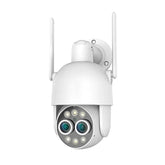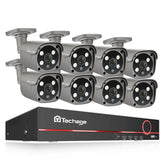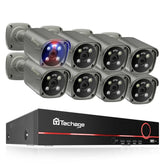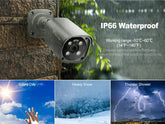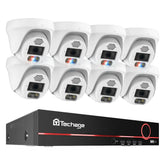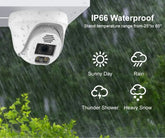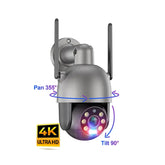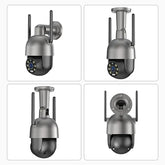Striking a Balance about IP Cameras and the Delicate Interplay of Security and Privacy
In an era where surveillance technology is rapidly advancing, striking a balance between security and individual privacy rights has become a critical challenge. IP cameras, with their advanced features and widespread usage, raise concerns about the potential invasion of privacy. In this blog post, we will delve into the complex issue of IP cameras and privacy, exploring the importance of striking a balance between security needs and respecting individual rights.
Clear Privacy Policies and Consent:
To address privacy concerns, organizations and individuals deploying IP cameras should establish clear privacy policies. These policies should outline the purpose of surveillance, the scope of data collection, and the retention period for recorded footage. Obtaining informed consent from individuals who may be captured by the cameras is crucial, ensuring transparency and respecting their privacy rights.
Purpose-Limited Surveillance:
IP cameras should be used for specific security purposes and not for indiscriminate monitoring or personal intrusion. Businesses and individuals should clearly define the areas under surveillance, ensuring that camera placement is focused on high-risk areas and sensitive locations. This targeted approach helps minimize the intrusion into private spaces and reduces the likelihood of unnecessary data collection.
Data Protection and Security Measures:
Protecting the data captured by IP cameras is paramount. Encryption, secure storage, and access controls should be implemented to safeguard recorded footage from unauthorized access or misuse. Regular security audits and updates to camera firmware are essential to mitigate the risk of data breaches. By prioritizing data protection, organizations demonstrate their commitment to privacy rights.
Anonymization and Masking:
In situations where privacy concerns are paramount, IP cameras can employ anonymization techniques. This involves masking or blurring individuals' faces or other personally identifiable information captured in the video footage. Anonymization strikes a balance between security and privacy, ensuring that individuals are not identifiable while still maintaining a level of surveillance effectiveness.
The primary objective of anonymization is to prevent the identification of individuals without hindering the surveillance capabilities of IP cameras. By masking or blurring faces, IP cameras can still capture and monitor activities, providing valuable insights for security purposes. This approach ensures that individuals remain anonymous, reducing the risk of privacy violations and potential misuse of the captured data.
Anonymization techniques extend beyond facial blurring and can also be applied to other identifiable information captured by IP cameras. For example, license plates, personal identification numbers, or sensitive documents can be obscured to prevent unauthorized access or misuse. This comprehensive approach to anonymization helps protect the privacy of not only individuals but also sensitive information that may be present in the video footage.
It is important to note that the level of anonymization applied should be proportional to the privacy risks and regulatory requirements. Striking the right balance between privacy and surveillance effectiveness is crucial. While complete anonymization may hinder the ability to identify potential threats or incidents accurately, insufficient anonymization may infringe upon individuals' privacy rights.
Compliance with Privacy Regulations:
Organizations using IP cameras must adhere to applicable privacy laws and regulations. Depending on the jurisdiction, there may be specific requirements regarding data collection, retention, disclosure, and individual rights. Understanding and complying with these regulations are crucial steps in respecting privacy rights and avoiding legal repercussions.
Public Awareness and Education:
Raising public awareness about the use of IP cameras and privacy concerns is vital. Educating individuals about their rights, the purpose of surveillance, and the measures taken to protect their privacy helps foster a more informed and responsible approach to security. Open communication channels between organizations and the public can address concerns, build trust, and encourage dialogue on privacy-related matters.
Regular Privacy Impact Assessments:
Periodic privacy impact assessments should be conducted to evaluate the impact of IP camera surveillance on individual privacy rights. These assessments can identify potential risks, assess the effectiveness of privacy safeguards, and recommend necessary adjustments. By proactively assessing privacy impacts, organizations can continuously refine their surveillance practices and mitigate any unintended privacy infringements.
Transparent Data Handling Practices:
Transparency is essential in maintaining trust with individuals whose data is being collected by IP cameras. Organizations should clearly communicate their data handling practices, including how long the data will be retained, who will have access to it, and the purposes for which it will be used. Transparency builds confidence among individuals that their privacy rights are respected and helps organizations establish a positive reputation in terms of privacy protection.
User Access and Control:
Providing individuals with control over their own personal data is a fundamental aspect of privacy protection. Organizations should implement mechanisms that allow individuals to access, review, and update their personal data collected by IP cameras. This can include providing a user portal or dashboard where individuals can manage their consent preferences, request data deletion, or report any concerns related to privacy.
Employee Training and Awareness:
Ensuring that employees are trained on privacy best practices is crucial for maintaining the integrity of IP camera surveillance. Employees should understand the importance of respecting privacy rights, following data protection protocols, and handling sensitive information appropriately. Regular training sessions and updates on privacy policies and procedures can help create a privacy-conscious culture within the organization.
Regular Audits and Compliance Checks:
Organizations should conduct regular audits to ensure compliance with privacy policies, procedures, and applicable regulations. These audits can assess the effectiveness of privacy safeguards, identify areas for improvement, and verify that the data handling practices align with privacy requirements. Compliance checks demonstrate a commitment to privacy protection and enable organizations to address any gaps or issues promptly.
Continuous Improvement and Adaptation:
The landscape of privacy and data protection is ever-evolving. Organizations should stay informed about emerging privacy trends, technological advancements, and regulatory changes that may impact IP camera surveillance. By staying proactive and adaptable, organizations can continuously improve their privacy practices, integrate new technologies that enhance privacy protection, and respond effectively to changing privacy expectations.
As IP cameras become increasingly prevalent, it is crucial to strike a balance between security needs and individual privacy rights. Clear privacy policies, obtaining informed consent, purpose-limited surveillance, data protection measures, anonymization techniques, compliance with privacy regulations, public awareness and education, regular privacy impact assessments, transparent data handling practices, user access and control, employee training, regular audits, and continuous improvement are all essential elements in safeguarding privacy rights. are key components of achieving this balance. By adopting responsible practices and respecting privacy rights, organizations can effectively leverage IP cameras for security while safeguarding the fundamental rights of individuals.A collaborative approach that prioritizes both security and privacy is essential in navigating the complex landscape of IP cameras and maintaining a harmonious society.


